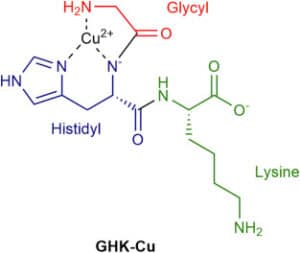Your cart is currently empty!
GHK-CU
GHK-Cu (Copper Peptide) is a powerful bioactive tripeptide composed of glycine, histidine, and lysine, which forms a complex with copper (Cu). It has gained significant attention in biomedical and cosmetic research for its regenerative properties, making it an attractive candidate for various therapeutic applications. Key Benefits of GHK-Cu for Research: Tissue Regeneration and Wound Healing: […]
Description
GHK-Cu (Copper Peptide) is a powerful bioactive tripeptide composed of glycine, histidine, and lysine, which forms a complex with copper (Cu). It has gained significant attention in biomedical and cosmetic research for its regenerative properties, making it an attractive candidate for various therapeutic applications.
Key Benefits of GHK-Cu for Research:
- Tissue Regeneration and Wound Healing: GHK-Cu has been shown to accelerate wound healing by promoting collagen synthesis, enhancing tissue repair, and reducing inflammation. It stimulates the production of essential components like elastin, proteoglycans, and glycosaminoglycans, making it a promising agent for skin regeneration studies.
- Anti-Inflammatory and Antioxidant Properties: Research shows that GHK-Cu has anti-inflammatory effects, which help reduce tissue damage in inflammatory conditions. Its antioxidant properties can also mitigate oxidative stress, making it relevant for studies focused on aging, chronic inflammation, and degenerative diseases.
- Cellular Health and Anti-Aging Potential: GHK-Cu has been found to rejuvenate aged skin cells, enhance DNA repair mechanisms, and modulate gene expression related to cellular repair, differentiation, and growth. Its ability to restore skin vitality has piqued interest in anti-aging research, including treatments for wrinkles, hyperpigmentation, and skin laxity.
- Neurological and Cognitive Benefits: Recent studies suggest that GHK-Cu might play a role in neural repair and cognitive function. Its neuroprotective effects are of particular interest in the treatment of neurodegenerative diseases, such as Alzheimer’s and Parkinson’s, offering new avenues for research in brain health and recovery.
- Wider Therapeutic Potential: Beyond dermatology and neurobiology, GHK-Cu has potential in treating chronic diseases, such as fibrotic conditions, COPD (chronic obstructive pulmonary disease), and even cancer. Its ability to modulate gene expression related to inflammation and cell growth makes it a versatile compound for drug discovery and molecular research.
Why Use GHK-Cu in Research?
- High Safety Profile: GHK-Cu is a naturally occurring peptide with low toxicity, making it safer for both in vitro and in vivo studies.
- Versatility: Its multifaceted role in wound healing, anti-aging, inflammation, and cell repair means it can be applied in a wide range of research fields.
- Strong Evidence Base: Multiple studies have already demonstrated its efficacy, but much remains unexplored, offering opportunities for novel discoveries.
Using GHK-Cu in research presents a promising avenue for developing new therapeutic approaches to tackle a wide range of health conditions. Its natural presence in the body and regenerative properties make it a top choice for cutting-edge biomedical investigations.
GHK-CU’s Structure

Additional information
| Strength | 100mg |
|---|







